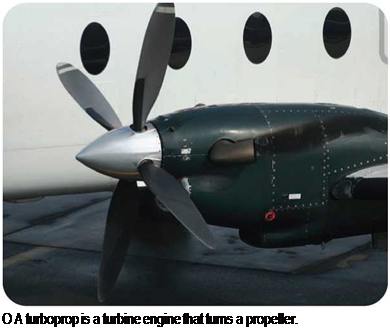How Propellers Work
When a propeller spins, its blades cut through the air. The blades work like wings standing on end, whirling around in a circle and producing thrust in a forward direction.
The first airplane propellers were made from a solid block of wood. The angle, or twist, of these early propellers’
|
TWISTING BLADES |
To work most effectively, propeller blades (like wings) have to meet the air at the right angle, which is called the angle of attack. The blades follow a complicated path through the air. They are rotating at the same time as the aircraft moves forward, so they follow a spiral path through the air.
In order for the blades to meet the air at the right angle, they have to be twisted.
A propeller’s blades are twisted more near the center than at the tip. Anyone who has ridden a merry-go – round or carousel knows that someone at the outside edge goes a lot faster than someone near the center.
The reason is that the person on the outside edge has to go a lot farther than someone near the center to make one spin of the merry-go – round. The two journeys take the same time, so the person at the edge travels faster. It is the same for a propeller. The tip of a blade goes faster than the part closer to the center, so the tip does not have to be twisted as much to create the same thrust as the rest of the blade.
_____________________________________________ J
blades could not be changed. The angle of the blades also is called the pitch, so these propellers are called fixed-pitch propellers. They worked most effectively
 at one particular speed. They did not work as well when a plane was moving slower or faster than this ideal speed.
at one particular speed. They did not work as well when a plane was moving slower or faster than this ideal speed.
Propellers with variable pitch allowed the blades to be twisted a little more or a little less so that the propeller worked better at different speeds. At first, the angle had to be changed by hand, and there were only two or three settings to choose from. Modern variable-pitch propellers automatically change the angle of the blades to suit the plane’s speed.
If an aircraft engine breaks down during a flight, air rushing through the propeller blades keeps the propeller spinning. A propeller that spins freely in this way causes drag. Extra drag on one side of a plane acts like a brake and makes the plane turn to that side. Some propellers are designed to prevent this from happening. They have blades with edges that can be turned toward the air to cut their drag. This is called feathering. Some planes can actually reverse their propeller blades so that they blow air forward instead of backward, a process called reverse thrust. It helps cargo planes, such as the military C-130 Hercules, stop a short distance after landing.
The amount of thrust a propeller produces depends on the amount of air it pushes backward and how much it speeds up the air. Making a propeller bigger or spinning it faster produces more thrust. Adding more blades to a
propeller also produces more thrust. The most efficient propellers move a large amount of air and speed it up a little.
Propeller planes are unable to increase their speed indefinitely. When they reach a speed of about 520 miles per hour (840 kilometers per hour), their propellers stop working so well. The problem is that the tips of the blades are moving faster than the speed of sound. The way that air flows around the blades changes at the speed of sound, and so propellers are no longer very good at producing thrust. The fastest that most propeller planes can fly is about 450 miles per hour (720 kilometers per hour).










